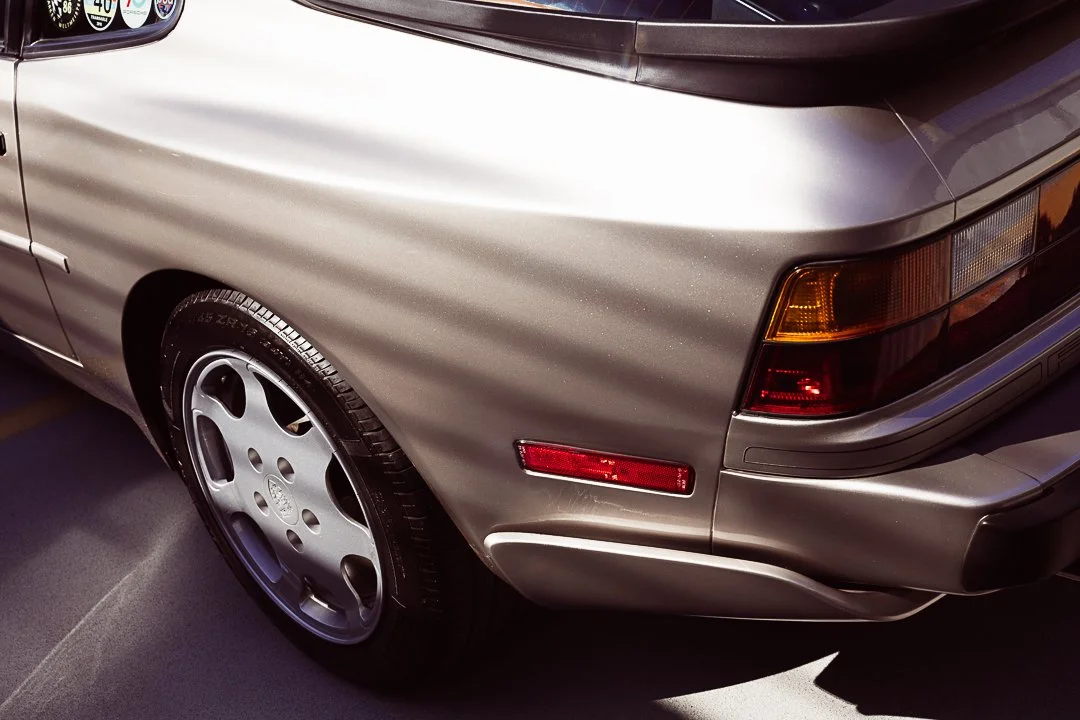Porsche 944 Turbo S Silver Rose
RAD RIDES - PORSCHE 944 TURBO S SILVER ROSE
STORY | EVAN GRIFFEY
PHOTOGRAPHY | KARL NOAKES
The 944 debuted on Porsche’s turnstile at the 1981 Frankfurt Motor Show. The show car, designed by Anatole Lapine, drew heavily from the 924 Carrera GT prototype from 1979. The production 944 carried over the hardest hitting design cues from the 924 Carrera GT, namely the aggressive widened rear haunches, contoured front end treatment, and low-slung stance.
The Porsche 944 hit the street in the wake of the 924, a controversial model that struggled to be recognized as a true Porsche. While the 944 shared its predecessor’s silhouette, the fact that Porsche developed the 2.5-liter inline four-cylinder itself pushed the 944 across the fi nish line of credibility. It was produced from 1982 to 1991 and has gone on to establish a solid rep on the street and at the track.
BATTLE-TESTED POWERPLANT
The 2.5-liter 944 four-cylinder engine has been described as half of a 4.5-liter V8 from the Porsche 928. It’s true the inline four uses the V8 architecture and a lot went into developing the 2.5-liter. With so much riding on the engine, Porsche needed to know what they had. Answer; Race it. What better place to test the mettle of an engine than the 24 Hours of Le Mans? Called a Porsche 924 GTP, the entry was actually a 944. The car, driven by Jürgen Barth and Walter Röhrl, ran trouble-free from green to checkers and fewer pit stops than its big-bore brethren. Its combination of speed, reliability, and economy resulted in an impressive seventh place overall fi nish. Today, with its shroud of secrecy long gone, the racer is known as the 944 GTR Le Mans.
NATURALLY ASPIRATED MODELS
Standard 944s delivered 147 horsepower from ’82 to ’88. Model year 1985.5 saw a noteworthy interior redesign, highlighted by an ovalshaped instrument panel in place of individual dials. In 1987 Porsche came out with an uprated model, the 944 S that had 187 horses on tap. For model year 1989 the base model’s engine was upgraded to a 2.7-liter, 16-valve that produced 163 horsepower while the new 944 S2 was bumped to 3.0 liters and an output of 208 horsepower. The S2 has a more muscular body, Brembo brakes, sportier suspension, and larger rear diffuser and rear spoiler. It was also available as a cabriolet.
944 UNDER PRESSURE
After a successful debut at the 1985 Geneva Motor Show, Porsche dropped the 944 Turbo in 1986. Known as the 951, this top-dog 944 featured re-worked front aerodynamics with motivation coming from a boosted 2.5-liter rated at 217 horsepower. The Turbo S version bowed in 1988 with a bigger turbo and more boost which pushed power to 247 horses. From ’89 to the end of the 944s production run in 1991 all 944 Turbos got the 247-horsepower engine. In its final model year, the 951 was offered as a convertible.
MAGGIE BROWN’S 1988 SILVER ROSE METALLIC PORSCHE 944 TURBO
Color us jealous. Maggie’s 944 sports the ultra-rare Silberrosa (L M3Z) Silver Rose Metallic paint which made it a must-have. “Silver Roses are hard to come by, and when this unicorn appeared on Porsche Club’s Marketplace I jumped,” says Maggie. “My dad, Todd, had a naturally aspirated ‘87 944 that he sold to another Avants member, and I missed it so much I bought my own. I was originally caught by the large ‘Turbo’ decal on the front right fender. I prefer earlier style bumpers over the later bumper covers, but I fell in love with the unique exterior color and plaid fabric interior design, combined with its very ‘80s style and moved quick to land the rare ride. Another fun fact is this exact car is the reference photo on Rennbow.org for the Silver Rose L M3Z color listing!”
Maggie appreciates the muscular lines of the 944 with its fl ared fenders and says there are no bad angles on the car. But she prefers to drive the car rather than look at it. “Unlike my dad’s older 911s, I love the smooth, confi dent driving feel of the 944. I don’t have a lot of high-performance driving experience, and the car’s nearly perfect 50/50 weight distribution with the transaxle in the rear makes cornering and higher-speed handling amazingly comfortable yet exhilarating.”
“I purchased this car in summer 2023,” relates Maggie, “so I haven’t built up a collection of adventures yet!” Get to work Maggie.
The 944 has a large pool of possibilities with 163,302 units being built during the car’s 10-year run so there are plenty to be had and a deep aftermarket and replacement part industry ready to keep them rolling.
Thanks to its timeless performance, tuning potential, and reliability, the 944 is on the rise, becoming more popular in the collector market and in the ranks of car enthusiasts like us.










